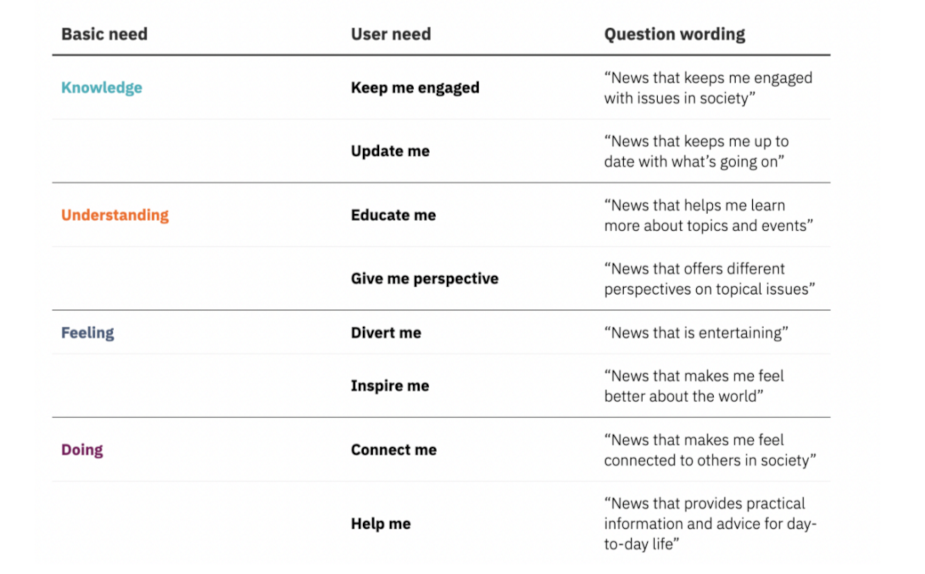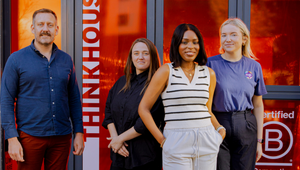
THINKHOUSE Spotlights News Consumption in the World

Following on from last week’s download on our ‘Future of News’ event, we continue on the theme of news with the Reuters Digital News Report 2024 launched this Monday, the largest ongoing comparative study of news consumption in the world. The launch event of the Irish version of the report included a panel discussion with our ‘Future of News’ panellists, Prof Colleen Murrell and Mark Little, alongside Amy A. Ross Arguedas and Susan Daly, in a session moderated by Sinead Crowley, director of media development, Coimisiún na Meán, (Ireland’s media regulator).
UNDERSTANDING USER NEEDS

Source: Reuters Digital News Report 2024
Much of the themes correlated with our ‘Future of News’ event last Tuesday - news avoidance (fatigue) and what it means for the reinvention of news formats; social media platforms and formats changing consumption behaviours; and the need for transparency especially around AI usage in news generation and the rise of explainer media from trusted news content creators and curators. The report itself, also referred to ‘user needs’ from news, similar to George Montagu’s presentation on the different modes of consumption for young news consumers (sift,
substantiate, study, socialise, sensemake), further reinforcing that, just as there are multiple types of news (sport, entertainment, business, politics etc.), we want different things from news at different times. Understanding audience needs and how best to deliver on them has never been more important for an industry that is vying for its own sustainability.
3 Areas to Spotlight with Our Youth Lens:
1. INTEREST IN NEWS

Source: Reuters Digital News Report Ireland 2024
According to the Irish report, there is a stark difference in news interest from young to old - for those aged 18-24 years old, only 30% claim to be ‘extremely’ or ‘very’ interested in news, whereas this rises to 73% for those aged 65+ year olds, (average for adult audience is 53%). There is also a big gender difference at play - (61% percent for male and 46% for female).
In terms of news avoidance, 44% of people claim to ‘often or sometimes’ avoid the news. Similarly, 40% claim to be ‘worn out by the amount of news these days.’ For 18-24 year olds, 34% share this sentiment, with 49% of 25-34 year olds feeling worn out. Here we see a
major male/female divide - 36% of males claim to feel worn out, but this rises to 45% for females. Not surprising then, more females than males look to avoid the news (46% for females, versus 41% for males).
In terms of interest in different types of news, the biggest variances can be seen with regard to people’s interest in political news. 26% of 18-24 year olds and 28% of 25-34 year olds claim to be ‘very’ or ‘extremely’ interested in political news, but this rises to 37% for 55-64 year olds and 45% for 65+ year olds.
Reflecting on our ‘Future of News’ event, and as discussed by the Reuters panel, the big opportunity for news producers to engage youth audience via explainer/sensemaking media as part of a ‘constructive journalism’ approach, and more broadly in developing native formats (online videos, podcasts etc.) that match their broad interests (wellness, technology, entertainment, business etc.).
“We are moving away from a form of news that is loud and noisy and serving their worst instincts and towards constructive journalism that plays to their best instincts.” - Mark Little, Entrepreneur - Media, Technology, Democracy
2. SOCIAL + SEARCH + AI - A NEW SEARCH BEHAVIOUR?

Source: Reuters Digital News Report Ireland 2024
It’s now official that the majority of Irish people get their news from online sources - for the first time ‘online, excluding social media’ (33%) has overtaken TV viewing (31%) as ‘the main source’ of news. Older age groups are more likely to navigate directly to a news site with 62 percent of those aged 65+ accessing news in this way, compared to 24 percent of those aged 18-24. 37 percent of 18-24 years claim social media as their main news source, compared to just 3 percent of 65+. When it comes to news discovery, YouTube, Instagram and TikTok top the polls for the under 35s. This ‘discovering of news’, according to Murrell, suggests a “certain passivity or potluck approach as most social media platforms have deprioritised news”.
Paradoxically, the next top choices were ‘using a search engine for a keyword for the name of a particular website’ (39%) or ‘using a search engine for a keyword for the name of a keyword about a particular news story’ (37%), both of which point to a more active searching model. This ‘search’ behaviour is something I’m very curious to track over the coming year with the growing popularity of search chatbots integrated into social media. Will we see growing numbers of young people accessing news in 2025 by asking an AI chatbot on social media to serve up real-time news? We think so.
This emerging behaviour has some key implications for young news consumers, news producers and social media giants.
1. The thing that chatbots currently are most prized for (answering Qs at top-speed) is where their biggest vulnerabilities lie. Currently, chatbots can’t be relied on to deliver fact-verified information given the questionability of their news sources (some sources themselves may be A.I. generated news websites of which Newsguard has identified 957 such sites). Young people’s media literacy skills and behaviour around source checking will need to go into overdrive.
2. Likewise, transparency in the process of news creation and distribution will become even more important. Even if more young people claim to be comfortable with news produced mostly by AI (24% of the under 35s are comfortable with news produced by artificial intelligence (AI) with some human oversight, versus 12% of those 35+), a significant number - 28% of under 35s - still claim to be uncomfortable with having news produced mainly by a journalist ‘with some AI input’ (this rises to 32% for 35s and over).
3. News producers and Social Media are going to have to grapple with new commercial models - if Meta is serving up news from The New York Times via its chatbot, then surely The New York Times deserves to be compensated, right? But of course Chatbots will likely be accessing multiple sources, so the news industry might, as the panel discussed, have to consider “collective action” in its bargaining power.
3. WHO OR WHAT ARE YOUNG NEWS CONSUMERS PAYING ATTENTION TO?
According to the report, while users of Facebook, X/Twitter and YouTube are likely to pay more attention to established media brands and professional journalists, when it comes to news, whereasTikTok users are more likely to pay attention to celebrities, influencers, and ordinary people. This finding correlates to both the growing trend of ‘creator journalism’ and our belief that while young people may not trust the media as an institution, they do trust content
creators who they share an affinity with and connect via lived experiences. Such content creators are also honing their skills for ‘explainer media’ which, according to the panel, offers opportunities, not just for content creators, but established news brands too. “Sensemaking” is, according to Little, what we should really be referring to when we refer to “news creation”.
On the subject of whether they’re prepared to pay for the news, last week we debunked the general theory that young people don’t pay for “the news”, highlighting that they will pay for it if it’s worth it. The report backs up these findings - while there has been a 2% increase in Irish news consumers paying for news content (from 15% to 17%) there is an increase of 7 percentage points in the number of 18-24 paying for digital news content. While the report highlights established media brands such as The Irish Times and The Journal, and International News Brands such The Guardian and The New York Times, we are curious to see Reuters track payments to content creators that aren’t actual journalists by trade, given the rise in online donations and subscription models from individual content creators.
A big shout out to all the team at Coimisiún na Meán, FuJo (DCU) and The Reuters Institute for this brilliantly comprehensive and informative work.
IN OTHER THINKHOUSE NEWS:
CANNES LIONS WINS FOR HEINEKEN
This week at the 2024 Cannes Lion Festival of Creativity, Heineken IRELAND has been awarded (to date) 7 Cannes Lions awards (3 x GOLDS and 4 x SILVERs) and nominated for a further 11 for outstanding creativity (including a TITANIUM award) for its Pub Museums, created by Publicis Dublin, LePub Milan and THINKHOUSE. The initiative is designed to celebrate and protect some of Ireland’s most historic pubs, including the oldest pub in the world; using the latest technology to transform them into museums. Check out Pub Museums at Sean’s Bar (Athlone), Toners (Dublin) and Mother Macs (Limerick).















